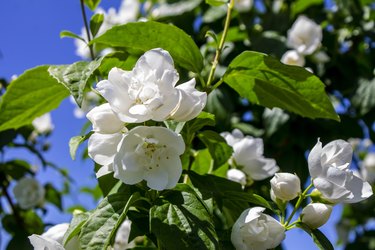
The prolific flowers of the jasmines (Jasminum spp.) are produced on more than 200 species of shrubs and vines that thrive in U.S. Department of Agriculture plant hardiness zones 6 through 11. The life span of a jasmine plant varies depending on whether it is grown within its hardiness zone or in colder climates where winter weather kills the plant. Many of the readily available jasmines grow so quickly that they can be grown as annuals and replaced each spring.
About the Jasmines
Video of the Day
While there are hundreds of jasmine species, only a few are found regularly in United States gardens. The common jasmine (Jasminum officinale), hardy in USDA zones 7 through 10, is a showy evergreen vine that produces a multitude of white to pink flowers. One vine can produce enough scent for an entire room or garden. You can grow a single vine in a pot with a trellis on the patio or in a sunny window. Keep it trimmed back to prevent it from taking over the room, as it can grow up to 40 feet tall and 15 feet wide under ideal conditions.
Video of the Day
If you're looking for color without scent, the deciduous winter jasmine (Jasminum nudiflorum) grows into a mound of trailing branches. In early winter in USDA zones 6 through 10, bright-yellow flowers appear on the leafless stems. Winter jasmine grows up to 4 feet tall and 7 feet wide.
Other jasmines include the white-flowering Arabian jasmine (Jasminum sambac, zone 9) and royal jasmine (Jasminum rex, zones 10-11). Arabian jasmine grows up to 10 feet tall, while royal jasmine vines may reach 8 feet long. Pink jasmine (Jasminum polyanthum) thrives in USDA zones 8 through 11. It is a fast-growing evergreen that flowers prolifically on vines of 25 feet or more.
Life Cycle and Life Span of Jasmine Flowers
Like other spring-flowering shrubs, the buds begin developing in late summer and fall for a spring display that may extend through summer and into early fall depending on the species. Trim these fast-growing vines and shrubs lightly to shape them but save the main pruning until just after the flowers have faded. Otherwise, you risk removing the buds for next spring's flowers. When blooming, the flowers may last for several days on the vines or may fade after 24 hours depending on the species.
Put on gloves and safety goggles and then sterilize your pruning tools by dipping the blades into rubbing alcohol or Lysol. While the cut stems ooze white sap, it is not considered toxic to humans or pets. Cut back the vines severely to reduce the jasmine's size and thin the remaining vines to increase air circulation through the plant.
The vines will recover quickly from pruning and will produce more flowers during the next growing season. The life span of a jasmine plant varies depending on the species, climate and care in the garden. The plants root readily from vines that touch the soil, so while the main plant may die, the new rooted vine tips are technically a continuation of the original plant.
Jasmine Plant Care
Jasmines prefer full sun and tolerate light shade, though flowering may be reduced due to the lack of sunlight. Plant in an organically rich, well-drained soil or amend average soils with compost. In cooler climates, a south-facing wall that receives full sun provides a warmer microclimate. Provide a tall, sturdy trellis for the vigorous vines.
Water regularly to keep the soil evenly moist but not waterlogged. Install a 3- to 4-inch layer of organic or bark mulch over the soil, pulling it back 4 inches from the jasmine's stems.
Fertilize lightly with a balanced, slow-release fertilizer by scattering the manufacturer's recommended amount over the mulch and watering in thoroughly. Fertilize in early spring and if the soil is poor, fertilize again in early summer to midsummer. Alternatively, apply several shovelfuls of well-decomposed compost around the plant every spring before the blossoms appear.